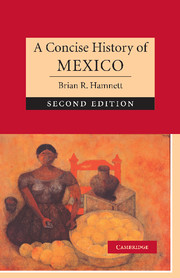Book contents
- Frontmatter
- Contents
- List of illustrations
- Chronology
- Preface to the second edition
- Preface to the first edition
- 1 Mexico in perspective
- 2 The pre-Columbian era
- 3 The European incursion, 1519–1620
- 4 New Spain, 1620–1770: Spanish colonialism and American society
- 5 Destabilisation and fragmentation, 1770–1867
- 6 Reconstruction, 1867–1940
- 7 The monopoly party, 1940–2000
- 8 The Fox administration, 2000–2006
- 9 Cultural developments since Independence
- Final comments
- Bibliography
- Index
- Titles in the series
1 - Mexico in perspective
Published online by Cambridge University Press: 05 June 2014
- Frontmatter
- Contents
- List of illustrations
- Chronology
- Preface to the second edition
- Preface to the first edition
- 1 Mexico in perspective
- 2 The pre-Columbian era
- 3 The European incursion, 1519–1620
- 4 New Spain, 1620–1770: Spanish colonialism and American society
- 5 Destabilisation and fragmentation, 1770–1867
- 6 Reconstruction, 1867–1940
- 7 The monopoly party, 1940–2000
- 8 The Fox administration, 2000–2006
- 9 Cultural developments since Independence
- Final comments
- Bibliography
- Index
- Titles in the series
Summary
Mexico may be part of the ‘New World’ (in the European nomenclature), but in reality much of the territory included within the present-day Republic formed part of a very old world unknown to Europeans before the end of the fifteenth century. This pre-Columbian past needs to be appreciated when attempting to explain both colonial and contemporary Mexico. We need to examine the way a distinct Mexican civilisation has expressed itself through time. The chronological and thematic sweep explains the structure and approach. The main purpose is to lay out the principal themes and issues. The detail may be found in many specific works. Contemporary Mexico has both an ostensibly stable political system and a capacity for grass-roots mobilisation, centrifugal tendencies, varied beliefs and distinctive local practices.
Modern territorial boundaries distort the cultural unities of the pre-Columbian world. The geographical dimension of Maya civilisation, for instance, included areas that would in colonial times become the southeastern territories of the Viceroyalty of New Spain (namely Yucatán) and the core territories of the Kingdom of Guatemala. Although sites like Palenque, Bonampak, and Yaxchilán are located in Chiapas, and Uxmal and Chichén Itzá in Yucatán, both states part of the Mexican Republic, Classic Period Maya sites such as Tikal, Uaxactún, and Copán are in the Republics of Guatemala and Honduras, respectively. Today, knowledge of Maya civilisation is disseminated in Mesoamerica from the capital city museums of contemporary states, even though these cities, particularly Mexico City, played no part at all in its original flourishing.
- Type
- Chapter
- Information
- A Concise History of Mexico , pp. 1 - 21Publisher: Cambridge University PressPrint publication year: 2006

